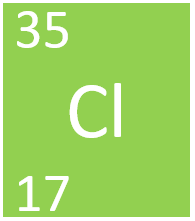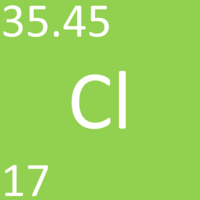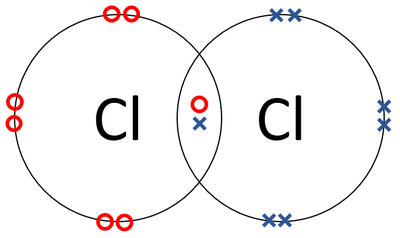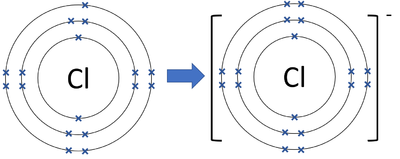Difference between revisions of "Chlorine"
(→About Chlorine) |
|||
| (16 intermediate revisions by 2 users not shown) | |||
| Line 3: | Line 3: | ||
[[Chlorine]] is a pale green [[gas]]. | [[Chlorine]] is a pale green [[gas]]. | ||
==Key Stage 3== | ==Key Stage 3== | ||
| + | [[File:ChlorineSymbol1.png|right|300px|thumb|The [[Chemical Symbol|chemical symbol]] for [[Chlorine]].]] | ||
| + | [[File:Cl-35_WK.PNG|right|200px|thumb|A 2 dimensional representation of a [[Chlorine]] [[atom]] with 17 [[proton]]s and 18 [[neutron]]s in the [[Atomic Nucleus|nucleus]] and 17 [[electron]]s orbiting the [[Atomic Nucleus|nucleus]].]] | ||
===Meaning=== | ===Meaning=== | ||
| − | |||
[[Chlorine]] is a [[Group 7]] [[element]], on the [[Periodic Table]], with an [[Atomic Number|atomic number]] of 17. | [[Chlorine]] is a [[Group 7]] [[element]], on the [[Periodic Table]], with an [[Atomic Number|atomic number]] of 17. | ||
===About Chlorine=== | ===About Chlorine=== | ||
| + | ====Molecular Structure==== | ||
: [[Chlorine]] has the [[Chemical Formula|chemical formula]] [[Chlorine| Cl<sub>2</sub>]]. | : [[Chlorine]] has the [[Chemical Formula|chemical formula]] [[Chlorine| Cl<sub>2</sub>]]. | ||
| + | ====Atomic Structure==== | ||
: [[Chlorine]] as 17 [[proton]]s and 18 [[neutron]]s in its [[Atomic Nucleus|nucleus]] giving it an [[Atomic Number]] of 17 and an [[Relative Atomic Mass|atomic mass]] of 35. | : [[Chlorine]] as 17 [[proton]]s and 18 [[neutron]]s in its [[Atomic Nucleus|nucleus]] giving it an [[Atomic Number]] of 17 and an [[Relative Atomic Mass|atomic mass]] of 35. | ||
| + | : An [[atom]] of [[Chlorine]] is missing one [[electron]] from having a full [[Outer Shell|outer shell]]. | ||
| + | |||
| + | ====Properties==== | ||
| + | : [[Chlorine]] is a [[non-metal]] [[element]]. | ||
: [[Chlorine]] is a more [[Reactivity|reactive]] [[Halogen]] than [[Bromine]] but less [[Reactivity|reactive]] than [[Fluorine]]. | : [[Chlorine]] is a more [[Reactivity|reactive]] [[Halogen]] than [[Bromine]] but less [[Reactivity|reactive]] than [[Fluorine]]. | ||
: [[Chlorine]] [[Chemical Reaction|reacts]] strongly with [[Hydrogen]] to produce [[Hydrogen Chloride]] which [[dissolve]]s in [[water]] to produce [[Hydrochloric Acid]]. | : [[Chlorine]] [[Chemical Reaction|reacts]] strongly with [[Hydrogen]] to produce [[Hydrogen Chloride]] which [[dissolve]]s in [[water]] to produce [[Hydrochloric Acid]]. | ||
| Line 14: | Line 21: | ||
: [[Chlorine]] kills [[bacteria]]. | : [[Chlorine]] kills [[bacteria]]. | ||
: [[Chlorine]] is a pale green coloured [[gas]] at [[STP|room temperature]]. | : [[Chlorine]] is a pale green coloured [[gas]] at [[STP|room temperature]]. | ||
| − | |||
| − | |||
==Key Stage 4== | ==Key Stage 4== | ||
| + | [[File:ClKS4.PNG|right|200px|thumb|The [[Chemical Symbol|chemical symbol]] for [[Chlorine]].]] | ||
| + | [[File:Cl-35_WK.PNG|right|200px|thumb|A 2 dimensional representation of the [[Bohr Model]] of a [[Chlorine]]-35 [[isotope]] with 17 [[proton]]s and 18 [[neutron]]s in the [[Atomic Nucleus|nucleus]] and 2 [[electron]]s in the first [[Electron Orbital|shell]], 8 in the second and 7 in the [[Outer Shell|outer shell]].]] | ||
===Meaning=== | ===Meaning=== | ||
| − | [[Chlorine]] is a [[Group | + | [[Chlorine]] is a [[Group 7]] [[element]], on the [[Periodic Table]], with 17 [[proton]]s in the [[Atomic Nucleus|nucleus]]. |
===About Chlorine=== | ===About Chlorine=== | ||
| + | ====Molecular Structure==== | ||
: [[Chlorine]] has the [[Chemical Formula|chemical formula]] [[Chlorine|Cl<sub>2</sub>]]. | : [[Chlorine]] has the [[Chemical Formula|chemical formula]] [[Chlorine|Cl<sub>2</sub>]]. | ||
| + | : [[Chlorine]] [[atom]]s join together in a [[Covalent Bond|covalent bond]]. | ||
| + | {| class="wikitable" | ||
| + | |- | ||
| + | |[[File:ChlorineDotandCrossDiagram.png|center|400px]] | ||
| + | |- | ||
| + | | style="height:20px; width:200px; text-align:center;" |A [[Dot and Cross Diagram|dot and cross diagram]] of a [[Chlorine]] [[molecule]]. | ||
| + | |} | ||
| + | |||
| + | ====Atomic Structure==== | ||
: There are two [[Stable Isotope|stable isotopes]] of [[Chlorine]], one with 18 [[neutron]]s and the other with 20 [[neutron]]s. They occur in a [[ratio]] of roughly 3:1 so the [[Relative Atomic Mass|atomic mass]] of [[Chlorine]] is 35.5. | : There are two [[Stable Isotope|stable isotopes]] of [[Chlorine]], one with 18 [[neutron]]s and the other with 20 [[neutron]]s. They occur in a [[ratio]] of roughly 3:1 so the [[Relative Atomic Mass|atomic mass]] of [[Chlorine]] is 35.5. | ||
| − | |||
| − | |||
{| class="wikitable" | {| class="wikitable" | ||
| style="height:20px; width:600px; text-align:center;" |[[Chlorine]] has two common [[Stable Isotope|stable]] [[Isotope]]s; [[Chlorine-35]] and [[Chlorine-37]]. [[Chlorine-35]] is three times more common than [[Chlorine-37]] so the ratio is 3:1. Find the [[Mean Average|average]] [[Relative Atomic Mass|atomic mass]] of [[Chlorine]]. | | style="height:20px; width:600px; text-align:center;" |[[Chlorine]] has two common [[Stable Isotope|stable]] [[Isotope]]s; [[Chlorine-35]] and [[Chlorine-37]]. [[Chlorine-35]] is three times more common than [[Chlorine-37]] so the ratio is 3:1. Find the [[Mean Average|average]] [[Relative Atomic Mass|atomic mass]] of [[Chlorine]]. | ||
| Line 45: | Line 60: | ||
So the [[Relative Atomic Mass]] of [[Chlorine]] is quoted as 35.5 on the [[Periodic Table]]. | So the [[Relative Atomic Mass]] of [[Chlorine]] is quoted as 35.5 on the [[Periodic Table]]. | ||
| + | |} | ||
| + | : An [[atom]] of [[Chlorine]] is missing one [[electron]] from having a full [[Outer Shell|outer shell]]. | ||
| + | : '''Chloride''' [[ion]]s gain 1 [[electron]] to get a full [[Outer Shell|outer shell]] and become [[Negative Charge|negatively charged]]. | ||
| + | {| class="wikitable" | ||
| + | |- | ||
| + | |[[File:ChlorineIonFormation.png|center|400px]] | ||
| + | |- | ||
| + | | style="height:20px; width:200px; text-align:center;" |A [[diagram]] showing the formation of a '''Chloride''' [[ion]]. | ||
|} | |} | ||
| + | ====Properties==== | ||
| + | : [[Chlorine]] is a [[non-metal]] [[element]]. | ||
: [[Chlorine]] is a more [[Reactivity|reactive]] [[Halogen]] than [[Bromine]] but less [[Reactivity|reactive]] than [[Fluorine]]. | : [[Chlorine]] is a more [[Reactivity|reactive]] [[Halogen]] than [[Bromine]] but less [[Reactivity|reactive]] than [[Fluorine]]. | ||
: [[Chlorine]] [[Chemical Reaction|reacts]] strongly with [[Hydrogen]] to produce [[Hydrogen Chloride]] which [[dissolve]]s in [[water]] to produce [[Hydrochloric Acid]]. | : [[Chlorine]] [[Chemical Reaction|reacts]] strongly with [[Hydrogen]] to produce [[Hydrogen Chloride]] which [[dissolve]]s in [[water]] to produce [[Hydrochloric Acid]]. | ||
| Line 52: | Line 77: | ||
: [[Chlorine]] kills [[bacteria]]. | : [[Chlorine]] kills [[bacteria]]. | ||
: [[Chlorine]] is a pale green coloured [[gas]] at [[STP|standard temperature and pressure]]. | : [[Chlorine]] is a pale green coloured [[gas]] at [[STP|standard temperature and pressure]]. | ||
| − | + | ||
| − | |||
====Testing For Chlorine==== | ====Testing For Chlorine==== | ||
#Collect the [[gas]] in a [[Test Tube|test tube]]. | #Collect the [[gas]] in a [[Test Tube|test tube]]. | ||
#Place a piece of [[Litmus Paper|litmus paper]] over the mouth of the [[Test Tube|test tube]]. | #Place a piece of [[Litmus Paper|litmus paper]] over the mouth of the [[Test Tube|test tube]]. | ||
#If the [[Litmus Paper|litmus paper]] is [[bleach]]ed white then the [[gas]] is [[Chlorine]] or [[Fluorine]]. | #If the [[Litmus Paper|litmus paper]] is [[bleach]]ed white then the [[gas]] is [[Chlorine]] or [[Fluorine]]. | ||
| + | |||
| + | ===References=== | ||
| + | ====AQA==== | ||
| + | |||
| + | :[https://www.amazon.co.uk/gp/product/1471851346/ref=as_li_tl?ie=UTF8&camp=1634&creative=6738&creativeASIN=1471851346&linkCode=as2&tag=nrjc-21&linkId=3ac654f4b0da781c49c855a1af4c92ea ''Chlorine, identification of, page 207, GCSE Chemistry, Hodder, AQA ''] | ||
| + | :[https://www.amazon.co.uk/gp/product/1782945962/ref=as_li_tl?ie=UTF8&camp=1634&creative=6738&creativeASIN=1782945962&linkCode=as2&tag=nrjc-21&linkId=476bb5c8d1dfb5c08ac81b6d4d1c98d8 ''Chlorine, page 61, GCSE Chemistry, CGP, AQA ''] | ||
| + | :[https://www.amazon.co.uk/gp/product/178294639X/ref=as_li_tl?ie=UTF8&camp=1634&creative=6738&creativeASIN=178294639X&linkCode=as2&tag=nrjc-21&linkId=51599bb45a2bfaf7c1b6a978b2ca2616 ''Chlorine, page 61, GCSE Combined Science Trilogy; Chemistry, CGP, AQA ''] | ||
| + | :[https://www.amazon.co.uk/gp/product/0198359381/ref=as_li_tl?ie=UTF8&camp=1634&creative=6738&creativeASIN=0198359381&linkCode=as2&tag=nrjc-21&linkId=47c8d1ae58d8b3a5e2094cd447154558 ''Chlorine, pages 102, 109, 185, GCSE Chemistry; Third Edition, Oxford University Press, AQA ''] | ||
| + | :[https://www.amazon.co.uk/gp/product/0008158762/ref=as_li_tl?ie=UTF8&camp=1634&creative=6738&creativeASIN=0008158762&linkCode=as2&tag=nrjc-21&linkId=a0fffa35b3ea49a63404f6704e0df7cc ''Chlorine, pages 15, 44-5, 64-5, 96, 165, 326, GCSE Chemistry; Student Book, Collins, AQA ''] | ||
| + | :[https://www.amazon.co.uk/gp/product/1782945598/ref=as_li_tl?ie=UTF8&camp=1634&creative=6738&creativeASIN=1782945598&linkCode=as2&tag=nrjc-21&linkId=ad276ad49df77ab4b40ab4fd0fe09767 ''Chlorine, pages 153, 163, GCSE Combined Science; The Revision Guide, CGP, AQA ''] | ||
| + | :[https://www.amazon.co.uk/gp/product/1782945571/ref=as_li_tl?ie=UTF8&camp=1634&creative=6738&creativeASIN=1782945571&linkCode=as2&tag=nrjc-21&linkId=9e29fad914244909903e5e93f8a01d80 ''Chlorine, pages 88, 102, GCSE Chemistry; The Revision Guide, CGP, AQA ''] | ||
| + | :[https://www.amazon.co.uk/gp/product/1471851362/ref=as_li_tl?ie=UTF8&camp=1634&creative=6738&creativeASIN=1471851362&linkCode=as2&tag=nrjc-21&linkId=7d78d70a2044ee9982dae010c94af92a ''Chlorine, test for, pages 160, GCSE Combined Science Trilogy 2, Hodder, AQA ''] | ||
| + | :[https://www.amazon.co.uk/gp/product/178294639X/ref=as_li_tl?ie=UTF8&camp=1634&creative=6738&creativeASIN=178294639X&linkCode=as2&tag=nrjc-21&linkId=51599bb45a2bfaf7c1b6a978b2ca2616 ''Chlorine; test for, page 203, GCSE Combined Science Trilogy; Chemistry, CGP, AQA ''] | ||
| + | :[https://www.amazon.co.uk/gp/product/1782945962/ref=as_li_tl?ie=UTF8&camp=1634&creative=6738&creativeASIN=1782945962&linkCode=as2&tag=nrjc-21&linkId=476bb5c8d1dfb5c08ac81b6d4d1c98d8 ''Chlorine; test for, page 257, GCSE Chemistry, CGP, AQA ''] | ||
| + | :[https://www.amazon.co.uk/gp/product/0008158762/ref=as_li_tl?ie=UTF8&camp=1634&creative=6738&creativeASIN=0008158762&linkCode=as2&tag=nrjc-21&linkId=a0fffa35b3ea49a63404f6704e0df7cc ''Chlorine; test, page 273, GCSE Chemistry; Student Book, Collins, AQA ''] | ||
| + | |||
| + | ====OCR==== | ||
| + | :[https://www.amazon.co.uk/gp/product/0198359829/ref=as_li_tl?ie=UTF8&camp=1634&creative=6738&creativeASIN=0198359829&linkCode=as2&tag=nrjc-21&linkId=90e8d7b4f039d53035238fa0320fe00b ''Chlorine, pages 40, 57, 86, 146, Gateway GCSE Chemistry, Oxford, OCR ''] | ||
Latest revision as of 14:01, 19 February 2021
Contents
Key Stage 2
Meaning
Key Stage 3
Meaning
Chlorine is a Group 7 element, on the Periodic Table, with an atomic number of 17.
About Chlorine
Molecular Structure
- Chlorine has the chemical formula Cl2.
Atomic Structure
- Chlorine as 17 protons and 18 neutrons in its nucleus giving it an Atomic Number of 17 and an atomic mass of 35.
- An atom of Chlorine is missing one electron from having a full outer shell.
Properties
- Chlorine is a non-metal element.
- Chlorine is a more reactive Halogen than Bromine but less reactive than Fluorine.
- Chlorine reacts strongly with Hydrogen to produce Hydrogen Chloride which dissolves in water to produce Hydrochloric Acid.
- Chlorine is a strong bleaching agent.
- Chlorine kills bacteria.
- Chlorine is a pale green coloured gas at room temperature.
Key Stage 4
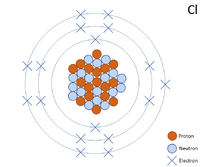
A 2 dimensional representation of the Bohr Model of a Chlorine-35 isotope with 17 protons and 18 neutrons in the nucleus and 2 electrons in the first shell, 8 in the second and 7 in the outer shell.
Meaning
Chlorine is a Group 7 element, on the Periodic Table, with 17 protons in the nucleus.
About Chlorine
Molecular Structure
- Chlorine has the chemical formula Cl2.
- Chlorine atoms join together in a covalent bond.
| A dot and cross diagram of a Chlorine molecule. |
Atomic Structure
- There are two stable isotopes of Chlorine, one with 18 neutrons and the other with 20 neutrons. They occur in a ratio of roughly 3:1 so the atomic mass of Chlorine is 35.5.
| Chlorine has two common stable Isotopes; Chlorine-35 and Chlorine-37. Chlorine-35 is three times more common than Chlorine-37 so the ratio is 3:1. Find the average atomic mass of Chlorine. |
| 1. State the known quantities.
Ratio: 3:1 3xChlorine-35 : 1xChlorine-37 |
| 2. Substitute the numbers into the equation and solve.
To find the average\[Average=\frac{35+35+35+37}{4}\] \(Average=\frac{35 \times 3 + 37 \times 1}{4}\) \(Average=35.5\) So the Relative Atomic Mass of Chlorine is quoted as 35.5 on the Periodic Table. |
- An atom of Chlorine is missing one electron from having a full outer shell.
- Chloride ions gain 1 electron to get a full outer shell and become negatively charged.
| A diagram showing the formation of a Chloride ion. |
Properties
- Chlorine is a non-metal element.
- Chlorine is a more reactive Halogen than Bromine but less reactive than Fluorine.
- Chlorine reacts strongly with Hydrogen to produce Hydrogen Chloride which dissolves in water to produce Hydrochloric Acid.
- Chlorine is a strong bleaching agent.
- Chlorine kills bacteria.
- Chlorine is a pale green coloured gas at standard temperature and pressure.
Testing For Chlorine
- Collect the gas in a test tube.
- Place a piece of litmus paper over the mouth of the test tube.
- If the litmus paper is bleached white then the gas is Chlorine or Fluorine.
References
AQA
- Chlorine, identification of, page 207, GCSE Chemistry, Hodder, AQA
- Chlorine, page 61, GCSE Chemistry, CGP, AQA
- Chlorine, page 61, GCSE Combined Science Trilogy; Chemistry, CGP, AQA
- Chlorine, pages 102, 109, 185, GCSE Chemistry; Third Edition, Oxford University Press, AQA
- Chlorine, pages 15, 44-5, 64-5, 96, 165, 326, GCSE Chemistry; Student Book, Collins, AQA
- Chlorine, pages 153, 163, GCSE Combined Science; The Revision Guide, CGP, AQA
- Chlorine, pages 88, 102, GCSE Chemistry; The Revision Guide, CGP, AQA
- Chlorine, test for, pages 160, GCSE Combined Science Trilogy 2, Hodder, AQA
- Chlorine; test for, page 203, GCSE Combined Science Trilogy; Chemistry, CGP, AQA
- Chlorine; test for, page 257, GCSE Chemistry, CGP, AQA
- Chlorine; test, page 273, GCSE Chemistry; Student Book, Collins, AQA
